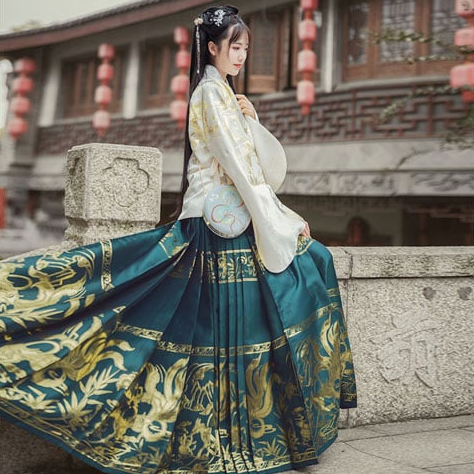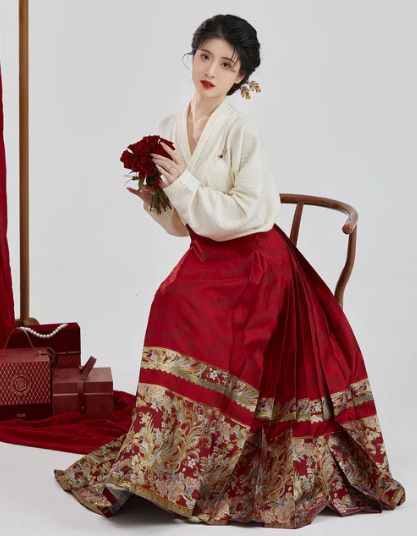Origins and Early History
The Mamian skirt, a unique garment, traces its roots to ancient China. This attire, often seen as a symbol of traditional Chinese fashion, emerged during a period marked by profound cultural and artistic development.
Emergence in Ancient China
During the formative years of Chinese civilization, the Mamian skirt began as a practical garment. Its design, initially simple, catered to the needs of daily life in ancient Chinese society. Artisans used natural fabrics, primarily silk and cotton, weaving them into durable yet elegant wear. The skirt’s distinct pleated style, which allowed for greater movement, quickly became popular among the people.

Cultural Significance in Early Dynasties
In the early dynasties, especially during the Tang and Song periods, the Mamian skirt took on significant cultural importance. It became more than just a piece of clothing; it was a symbol of grace and status. The intricate patterns and vibrant colors used in these skirts often indicated the wearer’s social standing. Emperors and nobles would have elaborate designs, while commoners wore simpler versions. During festivals and royal ceremonies, these skirts were prominent, showcasing the rich tapestry of Chinese culture. Their presence in ancient Chinese art and literature further cements their importance in the cultural heritage of China.
In each stage of its evolution, the Mamian skirt reflected the changing dynamics of Chinese society. From its practical origins to becoming a cultural icon, the skirt embodies the rich history and artistic spirit of ancient China.
Design and Construction
The design and construction of the Mamian skirt reflect a blend of functionality and aesthetics, a testament to the ingenuity of ancient Chinese tailoring. This garment stands out for its unique structure and meticulous craftsmanship.
Traditional Materials and Techniques
Craftsmen originally used natural fibers like silk and cotton, prized for their durability and comfort. Silk, especially, held a place of honor for its smooth texture and sheen, often reserved for higher-class garments. The construction process involved intricate pleating and stitching, techniques perfected over centuries. These methods ensured that the skirt was not only beautiful but also robust enough for everyday wear. The use of natural dyes, extracted from plants and minerals, added vibrant colors to the fabric, making each piece unique.
Evolution of Style and Patterns
Over time, the Mamian skirt evolved, mirroring changes in Chinese society and fashion. Initially, the designs were simplistic, focusing on functionality. As the garment gained prominence, especially during prosperous eras like the Tang Dynasty, the styles became more elaborate. Patterns began to incorporate symbolic motifs, such as dragons and phoenixes, which represented power and grace. The colors and intricacy of the patterns often indicated the wearer’s social status. With each passing dynasty, new styles emerged, influenced by the prevailing cultural and artistic trends. This evolution is well-documented in Chinese textile history, showcasing the skirt’s enduring legacy in fashion.
In every aspect, from the choice of materials to the evolving designs, the Mamian skirt is a remarkable example of traditional Chinese craftsmanship and cultural expression.
Geographical Spread and Influence
The Mamian skirt’s journey from a regional attire to an influential element in global fashion highlights the interconnectedness of cultures. This garment, rooted in ancient China, expanded its reach far beyond its initial borders.
Adoption in Neighboring Regions
Neighboring regions in Asia began adopting the Mamian skirt, each adding its unique twist to the design. Countries like Korea, Japan, and Vietnam, influenced by Chinese culture through trade and political relationships, integrated elements of the Mamian skirt into their traditional clothing. For instance, in Korea, the Hanbok, a traditional dress, shows similarities in its structure and design to the Mamian skirt. These adaptations reflect a blend of local styles with the fundamental design principles of the Mamian skirt, illustrating cultural exchange and appreciation.
Influence on Other Traditional Attires
The influence of the Mamian skirt extended even further, impacting the design of traditional attires in various cultures. In regions along the Silk Road, where Chinese traders and travelers brought their customs and fashion, local garments began to exhibit characteristics reminiscent of the Mamian skirt. These include the use of pleating, vibrant colors, and silk materials. The skirt’s influence is also evident in European fashion during certain periods, where Chinese textiles and designs were highly sought after. This global influence is a testament to the skirt’s timeless appeal and the far-reaching impact of Chinese culture, as documented in global textile history.
Through its widespread adoption and influence, the Mamian skirt serves as a symbol of cultural dialogue and exchange, showcasing the enduring legacy of traditional Chinese fashion.
Role in Social and Cultural Contexts
The Mamian skirt, beyond being a mere article of clothing, played a pivotal role in the social and cultural fabric of ancient China, symbolizing both tradition and status.
Significance in Ceremonies and Festivals
In ceremonies and festivals, the Mamian skirt was a centerpiece of traditional attire. During weddings, it was customary for brides to wear elaborately designed Mamian skirts, symbolizing beauty and elegance. Festivals like the Lunar New Year saw people donning these skirts as a celebration of heritage and prosperity. The vibrant colors and intricate patterns of the skirts were not just for aesthetic appeal; they were also symbolic of good fortune and happiness. These practices highlight the skirt’s importance in key cultural events and its role in perpetuating Chinese traditions.
Symbolism in Social Hierarchy and Gender Roles
The Mamian skirt also embodied the nuances of social hierarchy and gender roles in ancient China. The quality and complexity of the skirt often reflected the wearer’s social status. Nobles and royalty wore skirts with finer materials and more elaborate designs, while commoners had simpler versions. Regarding gender roles, the skirt was a symbol of femininity and grace, often associated with traditional female virtues in Chinese culture. This symbolism is evident in classical Chinese literature and art, where women in Mamian skirts are often depicted as embodiments of beauty and refinement. The skirt’s representation in these mediums, which you can explore in more depth on Chinese cultural history, offers insights into the societal values and norms of the time.
In essence, the Mamian skirt was not just a piece of clothing but a marker of cultural identity and societal values, deeply ingrained in the traditions and customs of ancient China.

Modern Revival and Adaptations
In recent times, the Mamian skirt has witnessed a remarkable revival, adapting to modern fashion trends while retaining its cultural essence.
Contemporary Fashion Incorporations
Fashion designers have creatively incorporated elements of the Mamian skirt into contemporary clothing. These modern adaptations often blend traditional motifs with new materials and designs. For instance, the use of lighter, more sustainable fabrics aligns with current fashion trends, while digital printing techniques allow for intricate patterns that echo the traditional styles. High-profile fashion shows often feature these modern interpretations, attracting a global audience and rekindling interest in this historical garment. These adaptations demonstrate a harmonious fusion of tradition and modernity, keeping the Mamian skirt relevant in today’s fashion landscape.
Role in Cultural Preservation Movements
The revival of the Mamian skirt also plays a crucial role in cultural preservation movements. It has become a symbol of Chinese heritage, celebrated in cultural festivals and exhibitions. Efforts to preserve traditional techniques in skirt making are gaining momentum, with artisans and designers working together to keep these skills alive. This cultural resurgence is not just about fashion; it’s a way to maintain a tangible connection to the past. Initiatives to include the Mamian skirt in educational programs and museum collections are underway, as seen in the increasing number of exhibits dedicated to traditional Chinese attire. These efforts, well-documented in resources like cultural preservation, highlight the importance of the Mamian skirt in the broader context of heritage conservation.
Through its modern adaptations and role in cultural preservation, the Mamian skirt continues to be an enduring emblem of China’s rich history and artistic heritage.
Mamian Skirt in Art and Literature
The Mamian skirt, rich in history and tradition, has significantly influenced both art and literature, leaving a lasting impression as a symbol of Chinese culture.
Depictions in Historical Artworks
In historical artworks, the Mamian skirt frequently emerges as a focal point, beautifully capturing the essence of traditional Chinese fashion. These depictions, ranging from intricate paintings to detailed sculptures, showcase women adorned in these elegant skirts, often as embodiments of grace and status. Artists, with a keen eye for detail, meticulously portrayed the vibrant colors and elaborate patterns of the skirts. Found in esteemed collections worldwide, these artworks, which enthusiasts can explore through resources like Chinese art history, provide a rich visual record of the Mamian skirt’s evolution and its cultural significance.
References in Classical and Modern Literature
Similarly, in literature, the Mamian skirt enjoys a celebrated presence. Classical Chinese poets and novelists frequently depicted their heroines in these skirts, using them as metaphors for beauty, elegance, and traditional values. Furthermore, modern writers often weave references to the Mamian skirt into their narratives, either as a nostalgic nod to the past or as a symbol of the enduring allure of Chinese traditions. These literary pieces, bridging the ancient and the contemporary, underscore the Mamian skirt’s deep-rooted significance in the fabric of Chinese cultural expression.
The Mamian skirt thus stands as a vibrant thread in the tapestry of Chinese art and literature, symbolizing a rich cultural heritage that continues to inspire and resonate across generations.